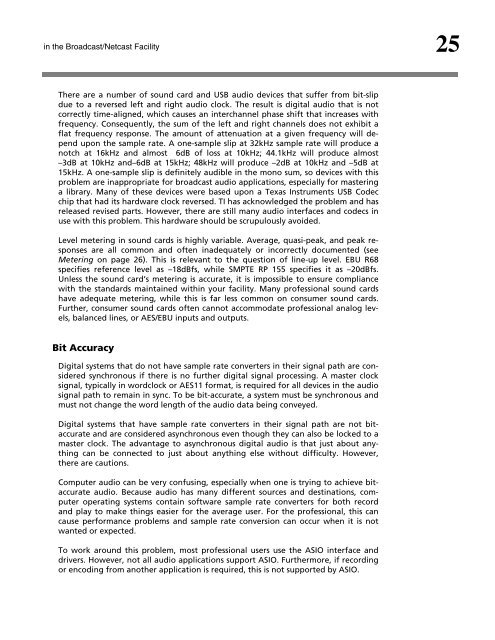Maintaining Audio Quality in the Broadcast Facility 2011 - Orban
Maintaining Audio Quality in the Broadcast Facility 2011 - Orban
Maintaining Audio Quality in the Broadcast Facility 2011 - Orban
Create successful ePaper yourself
Turn your PDF publications into a flip-book with our unique Google optimized e-Paper software.
<strong>in</strong> <strong>the</strong> <strong>Broadcast</strong>/Netcast <strong>Facility</strong> 25<br />
There are a number of sound card and USB audio devices that suffer from bit-slip<br />
due to a reversed left and right audio clock. The result is digital audio that is not<br />
correctly time-aligned, which causes an <strong>in</strong>terchannel phase shift that <strong>in</strong>creases with<br />
frequency. Consequently, <strong>the</strong> sum of <strong>the</strong> left and right channels does not exhibit a<br />
flat frequency response. The amount of attenuation at a given frequency will depend<br />
upon <strong>the</strong> sample rate. A one-sample slip at 32kHz sample rate will produce a<br />
notch at 16kHz and almost 6dB of loss at 10kHz; 44.1kHz will produce almost<br />
–3dB at 10kHz and–6dB at 15kHz; 48kHz will produce –2dB at 10kHz and –5dB at<br />
15kHz. A one-sample slip is def<strong>in</strong>itely audible <strong>in</strong> <strong>the</strong> mono sum, so devices with this<br />
problem are <strong>in</strong>appropriate for broadcast audio applications, especially for master<strong>in</strong>g<br />
a library. Many of <strong>the</strong>se devices were based upon a Texas Instruments USB Codec<br />
chip that had its hardware clock reversed. TI has acknowledged <strong>the</strong> problem and has<br />
released revised parts. However, <strong>the</strong>re are still many audio <strong>in</strong>terfaces and codecs <strong>in</strong><br />
use with this problem. This hardware should be scrupulously avoided.<br />
Level meter<strong>in</strong>g <strong>in</strong> sound cards is highly variable. Average, quasi-peak, and peak responses<br />
are all common and often <strong>in</strong>adequately or <strong>in</strong>correctly documented (see<br />
Meter<strong>in</strong>g on page 26). This is relevant to <strong>the</strong> question of l<strong>in</strong>e-up level. EBU R68<br />
specifies reference level as –18dBfs, while SMPTE RP 155 specifies it as –20dBfs.<br />
Unless <strong>the</strong> sound card’s meter<strong>in</strong>g is accurate, it is impossible to ensure compliance<br />
with <strong>the</strong> standards ma<strong>in</strong>ta<strong>in</strong>ed with<strong>in</strong> your facility. Many professional sound cards<br />
have adequate meter<strong>in</strong>g, while this is far less common on consumer sound cards.<br />
Fur<strong>the</strong>r, consumer sound cards often cannot accommodate professional analog levels,<br />
balanced l<strong>in</strong>es, or AES/EBU <strong>in</strong>puts and outputs.<br />
Bit Accuracy<br />
Digital systems that do not have sample rate converters <strong>in</strong> <strong>the</strong>ir signal path are considered<br />
synchronous if <strong>the</strong>re is no fur<strong>the</strong>r digital signal process<strong>in</strong>g. A master clock<br />
signal, typically <strong>in</strong> wordclock or AES11 format, is required for all devices <strong>in</strong> <strong>the</strong> audio<br />
signal path to rema<strong>in</strong> <strong>in</strong> sync. To be bit-accurate, a system must be synchronous and<br />
must not change <strong>the</strong> word length of <strong>the</strong> audio data be<strong>in</strong>g conveyed.<br />
Digital systems that have sample rate converters <strong>in</strong> <strong>the</strong>ir signal path are not bitaccurate<br />
and are considered asynchronous even though <strong>the</strong>y can also be locked to a<br />
master clock. The advantage to asynchronous digital audio is that just about anyth<strong>in</strong>g<br />
can be connected to just about anyth<strong>in</strong>g else without difficulty. However,<br />
<strong>the</strong>re are cautions.<br />
Computer audio can be very confus<strong>in</strong>g, especially when one is try<strong>in</strong>g to achieve bitaccurate<br />
audio. Because audio has many different sources and dest<strong>in</strong>ations, computer<br />
operat<strong>in</strong>g systems conta<strong>in</strong> software sample rate converters for both record<br />
and play to make th<strong>in</strong>gs easier for <strong>the</strong> average user. For <strong>the</strong> professional, this can<br />
cause performance problems and sample rate conversion can occur when it is not<br />
wanted or expected.<br />
To work around this problem, most professional users use <strong>the</strong> ASIO <strong>in</strong>terface and<br />
drivers. However, not all audio applications support ASIO. Fur<strong>the</strong>rmore, if record<strong>in</strong>g<br />
or encod<strong>in</strong>g from ano<strong>the</strong>r application is required, this is not supported by ASIO.



![[PDF] Using the ITU BS.1770-2 and CBS Loudness Meters ... - Orban](https://img.yumpu.com/50629372/1/190x245/pdf-using-the-itu-bs1770-2-and-cbs-loudness-meters-orban.jpg?quality=85)






![[PDF] Optimod-FM Feature Comparison - Orban](https://img.yumpu.com/41741615/1/190x245/pdf-optimod-fm-feature-comparison-orban.jpg?quality=85)






